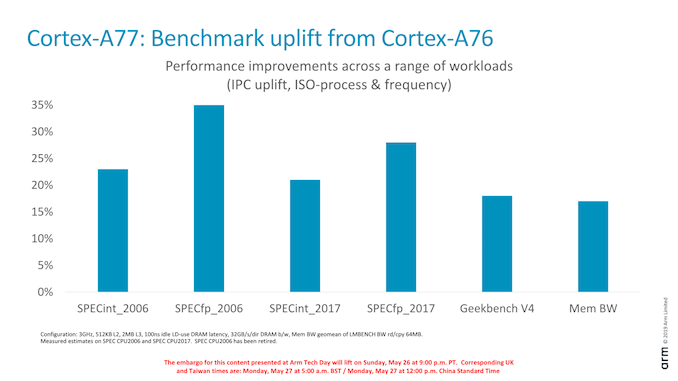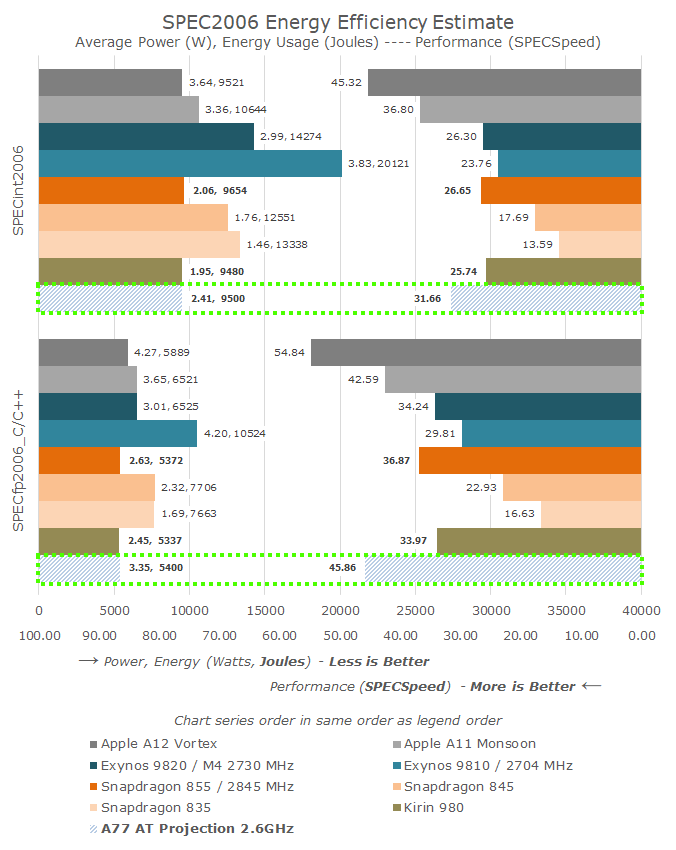Arm's New Cortex-A77 CPU Micro-architecture: Evolving Performance
by Andrei Frumusanu on May 27, 2019 12:01 AM ESTPerformance Targets: 20-35% Better IPC
The Cortex-A77 saw some interesting microarchitectural changes that promise to increase performance. The question now remains where exactly the targeted performance gains will end up at?
In terms of published performance improvements, Arm opted to stay with SPEC2006, 2017, GeekBench4 and LMBench memory bandwidth. Our focus here will be on SPEC2006 as it’s still the most relevant benchmark among the set for mobile.
On SPECint2006, the A77 promises around a 23% IPC increase, while SPECfp2006 claims a more staggering 35% boost. The 23% increase for integer workloads was more or less in line with what we expected of the CPU core, however the 30-35% increase for FP workloads I must admit came as quite a surprise, particularly since we haven’t seen any significant changes on the FP execution units of the core. An explanation here would be that SPEC’s FP test suite is more memory intensive than the integer suite, and the Cortex-A77’s various microarchitectural improvements would be more visible in these workloads.
Last year I had made performance and efficiency projections for the A76 at two frequency points, and I ended up being quite close to where the Kirin 980 and Snapdragon 855 ended up landing. For the Cortex-A77, things should be a lot more straightforward to project as we won’t see major process node changes in the next generation 7nm SoCs.
Baselining on the current results of the Kirin 980, I simply extrapolated performance based on the published IPC increases for a theoretical 2.6GHz Cortex-A77 SoC. It’s to be noted that although Arm this year again talks about 3GHz target frequencies for the A77, I’m not expecting vendors to quite reach this frequency in upcoming SoCs, thus the 2.6GHz projection.
In terms of performance, the integer suite would see some solid improvement, however the floating-point results are a lot more interesting. If correct, the A77 would exceed the FP performance of Apple’s A11 and make for quite a big generational push even though we’re not expecting big process node improvements. It’s to be noted though that the A77 will have to compete with Apple’s A13 later this year as well as next-gen M5 cores from Samsung.
Arm promises energy efficiency of the A77 will remain the same as current-gen A76 SoCs. Thus at peak performance, both CPU cores would use the same amount of energy to complete a set workload. The increased performance of the A77 would however have one drawback: Increased power usage, linear with the increased performance figures. This latter increased power usage would seemingly reach levels where running more than two cores at peak frequency would be more problematic in a mobile SoC. Luckily, most vendors have moved on from 4 full-speed big cores to 2+2 or 3+1 designs where there’s only one or two high-power big cores.
It’s to be noted although we’re talking about big cores here, the A77 is said to be only 17% bigger than the A76 – still significantly smaller than the next best microarchitecture from the competition.
End Remarks
Overall the Cortex-A77 announcement today isn’t quite as big of a change as what we saw last year with the A76, nor is it as big a change as today’s new announcement of Arm’s new Valhall GPU architecture and G77 GPU IP.
However what Arm managed to achieve with the A77 is a continued execution of their roadmap, which is extremely important in the competitive landscape. The A76 delivered on all of Arm’s promises and ended up being an extremely performant core, all while remaining astonishingly efficient as well as having a clear density lead over the competition. In this regard, Arm’s major clients are still heavily focusing on having the best PPA in their products, and Arm delivers in this regard.
The one big surprise about the A77 is that its floating point performance boost of 30-35% is quite a lot higher than I had expected of the core, and in the mobile space, web-browsing is the killer-app that happens to be floating point heavy, so I’m looking forward how future SoCs with the A77 will be able to perform.
But even in the integer workloads a 20-25% IPC gain is absolutely marvellous improvement, and we do trust Arm to be able to maintain energy efficiency of the A76. Power will go up slightly, but I think the industry has shown that mobile devices today handle at least two higher power cores properly, so future SoCs should continue with big+middle+little CPU configurations.
Coming A77 SoCs from vendors are expected to still be 7nm – Qualcomm and HiSilicon are the two obvious leading customers that would adopt the core and I’m expecting similar timeframes as last generation’s chipsets. For now- Arm’s delivering on their promised 20-25% yearly CAGR and we believe this to continue for the foreseeable next few generations.












108 Comments
View All Comments
Valis - Thursday, May 30, 2019 - link
Yeah, it's because he is a white male, probably hetero also. :Praptormissle - Monday, May 27, 2019 - link
So it looks like the SD 865 is finally going to break the 4000 geekbench single core score and probably score 12000+ in multi core. ARM has finally leveled the playing field with Apple as I really don't expect major gains from the A13 as they've likely blown their wad.GC2:CS - Monday, May 27, 2019 - link
There were big gains from going from 16/14 nm in 2016 to 7 nm in 2018.While performance gains were impresive in that time, no shrink like that coming any time soon.
76 was a big performance jump, but that was after many regular releases where ARM had overestimeted or even regresed on their performance metrics in reality (Or so i think... Am I right ?).
And Apple does not make promises, but they are expected (based on like 5 (how many ?!?) generations of big performance jumps) to deliver something crazy, which they can fail.
Honestly I would happily take the same performance with lower power. And cut/cap the peak power as well... not planing to buy a fan equped phone.
Wilco1 - Monday, May 27, 2019 - link
There is a 7+nm shrink coming this year and then another huge one with 5nm next year. So big shrinks are continuing at least at TSMC.And performance has increased hugely with each generation since Cortex-A57. The smallest gain was with Cortex-A73, but that still improved sustained performance and efficiency considerably.
Many phones support battery saving modes which limit the frequency of the big cores (or switch them off). So you can already get what you want if battery life is your goal. I find these modes very useful but you clearly notice the performance loss while browsing.
Santoval - Monday, May 27, 2019 - link
"or even regresed on their performance metrics in reality (Or so i think... Am I right ?)."Indeed, the A73 core was usually slower than the A72 core, or at best just as fast, though it was supposed to be the successor core.
blu42 - Tuesday, May 28, 2019 - link
CA73 was not exactly 'usually slower' than CA72 -- former was usually slower at asimd workloads, but it was going better at spaghetti code (even with the narrower frontend), of which there's more in this world. We now have CA57s, CA72s and CA73s all in affordable SBCs (finally!), so people can check for themselves.BTW, CA73 was a successor but it was not meant to be a performance improvement, rather than an efficiency improvement, and there it delivered, IMO
ZolaIII - Tuesday, May 28, 2019 - link
A73 is a two instructions wide vs A72 three instructions wide OoO design. While performance all together whose the same the gain in performance per W whose 30~33% & per mm² 27~28%.name99 - Tuesday, May 28, 2019 - link
The A10 was based on 16nm, just like the A9. But came with a substantial improvement...You guys are way too ignorant of the role of micro architecture in performance. Apple’s speed boosts so far (since A7) are pretty much exactly split 50% micro-architecture and 50% frequency (so process).
The A13 based on 7nm is still capable of large improvements; firstly from micro-arch improvements, second from having a chance to optimize what’s already there (like, as I said, the A10 as second pass through 16nm).
galdutro - Monday, May 27, 2019 - link
Given ther track record, I would be surprised if the A13 had the same performance as the A12X. YES, this is crazy! But it is what they actually have been able to achiave in the past couple of generations.galdutro - Monday, May 27, 2019 - link
typos: their* wouldn´t** achieve***